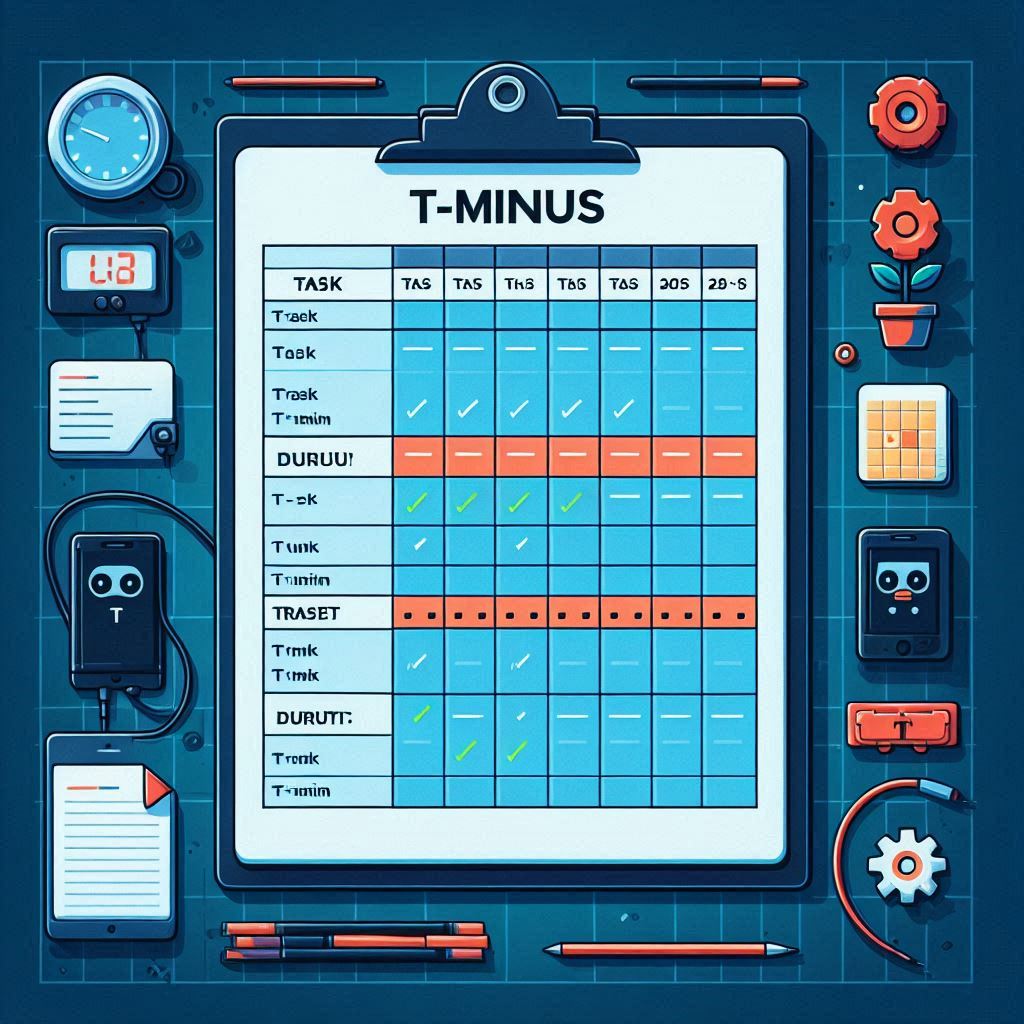· Planning · 7 min read
T-Minus THIS!

Do you frequently experience slipped due dates? Have you been looking for a way to shore up your projects and start delivering your projects on time and on-budget? Then T-Minus lists might be right for you!!!
What is a T-Minus list for development projects?
They are a roadmap of what activities need to get done in what order, who is responsible for them, how long they will take, and when they will be done. They help organize your work and plan releases. Giving a realistic picture of when work can be delivered. They are valuable in all projects and especially valuable in larger projects.
How would my projects benefit?
T-Minus lists provide you a timeline of effort. Building this timeline does several things that are helpful.
- Achievable Deadlines: It allows you to set project deadlines that are achievable.
- Resource Allocation: It allows you to better allocate your team.
- Project Coordination: It helps you coordinate the timing of your projects, especially when managing multiple projects.
- Communication: It gives you the detail you need to communicate with both your team and your client in an accurate and meaningful way.
- Accountability: It allows you to increase the accountability of the team and your organization.
When you look back at your projects, have you frequently seen missed deadlines? Or poorly set expectations? Did your project have such a timeline?
How do they work?
They are pretty simple. At their core they are just a list, generally in order of when a task starts, that end in the release of a change, new feature, or whole project. My preference is to use tables to separate and organize this.
You can use a variety of columns. At a bare minimum you need:
- Task Name/Description - Either a short name or description of the task that should be done.
- Duration (hours or days) - How many days or hours the task will take.
- T-Minus Days - The number of days prior to launch that this will completed.
This gives you the basics of what you need to plot out a plan and determine the timelines. But we can do better than this. For a more detailed plan consider this set of columns.
- Task ID/# - A list reference ID for this task on this list.
- Owner - Who is responsible for the task completion. Sometimes I include this at the beginning of the task description instead. However, doing that limits this and makes ownership less visible.
- Task Description - Short description of the task.
- Dependencies - The number of the prior task(s) that have to be completed before starting this one.
- Duration - How many days or hours of actual work the task will take to get done.
- Start Date - When this has to be started by.
- End Date - When this has to be completed by.
- Status - What the current status of the task is.
- T-Minus - How many days before launch that this task will be completed by.
This more expansive list helps you visualize the timeline better. Dates should take in consideration days off (holidays, weekends, PTO, etc).
What does a T-Minus Table look like?
Here is an example of a T-Minus table I created recently.
| ID | Owner | Description | Duration | Dependencies | Start Date | End Date | Status | T-Minus |
|---|---|---|---|---|---|---|---|---|
| 1 | Creative | Wireframes | 22d | Oct 16th | Nov 6th | Completed | 62d | |
| 2 | Creative | UX designs | 8d | 1 | Nov 6th | Nov 13th | In Progress | 55d |
| 3 | Creative | Creative Handoff | 1 hour | 2 | Nov 14th | Nov 14th | Scheduled | 54d |
| 4 | CX | Build out career matrix | 4 | Oct 11th | Oct 15th | Complete | ||
| 5 | Dev | Create Quiz Logic/Implement in Module | 2 | 3 | Nov 15th | Nov 18th | Scheduled | 50d |
| 6 | Dev | Build taxonomy for quiz questions/answers | 2 hours | 4 | Nov 19th | Nov 19th | Scheduled | 49d |
| 7 | Dev | Create field to associate careers | 2 hours | 6 | Nov 19th | Nov 19th | Scheduled | 49d |
| 8 | Dev | Build JSON structure | 3 | 4 | Nov 20th | Nov 22nd | Scheduled | 46d |
| 9 | Dev | Build quiz display/interactions | 5 | 3, 5, 6, 7, 8 | Nov 25th | Dec 4th | Scheduled | 34d |
| 10 | Dev | Build results page | 4 | 9 | Dec 5th | Dec 10th | 29d | |
| 11 | Dev | Final tasks and cleanup | 2 | 10 | Dec 11th | Dec 12th | Scheduled | 27d |
| 12 | Dev, TechOps | Deploy to author | 2 hours | 10, 11 | Dec 13th | Dec 13th | Scheduled | 26d |
| 13 | Content | Associate careers to taxonomy terms | 2 | 7 | Dec 14th | Dec 16th | Scheduled | 23d |
| 14 | QA | Test quiz logic | 1 | 12 | Dec 16th | Dec 17th | Scheduled | 22d |
| 15 | QA | Test quiz functionality/UX | 2 | 12 | Dec 17th | Dec 19th | Scheduled | 20d |
| 16 | Client | UAT Review | 3 | 13, 14 | Dec 20th | Jan 3rd | Scheduled | 5d |
| 17 | TechOps | Deploy to Pre-Prod | 1 hour | 15 | Jan 7th | Jan 7th | Scheduled | 1d |
| 18 | TechOps | Deploy to production | 1 hour | 15 | Jan 8th | Jan 8th | Scheduled | 0 |
I build my tables and my notes in Markdown format using Obsidian (I will have to write an article about that sometime). So the formatting is pretty easy with the right plugins. But you can build this in any spreadsheet or text editing tool you like. I just prefer lightweight tools myself.
Are there other columns you would want to see on one of these lists? Comment below and let me know.
How do I build one?
So what is the process I need to follow to make a T-Minus list? It is fairly simple, though can take time to work through. Here are the steps needed.
- Start with a project you need to complete.
- Then break it down into the over-arching tasks that have to be accomplished to finish the project.
- Next, estimate how long each task will take. For shorter tasks we can do it down to hours.
- Now organize the tasks based on what has to be done first for other tasks to get done.
- Finally, use the timeline that evolves from this to determine how soon you can launch the project.
When you do this don’t forget to get buy-in from your team. You should also be sure to asign clear owners to each task. As with any well-managed project there should also be regular standups to communicate where things are at, ask questions, and elevate blockers.
Why would I make a T-Minus list?
As you can see from the process of building a T-Minus list, you will be able to highlight how long it will take and how soon it can get done. This is important both for setting proper expectations and for determining feasibility. With this you can make adjustments.
If the client is asking to get this done in 30 days, but it will take 45 days to accomplish, then you will know upfront that you can’t deliver what is asked in the timeframe given. This allows you to step back and find what you can do.
What can you do if you can’t deliver in the timeframe given?
This is an important question you should always ask yourself. Never hide you head in the sand about things. Instead, address the problem head on. You can do this in multiple ways.
You can…
- Reduce the size of the ask - Ask yourself what is trying to be accomplished. Can it be accomplished with fewer features or a different ask?
- Reprioritize other projects - Is work on other projects preventing this new ask from getting done when they need it? If so, can they be moved around?
- Allocate more resources - Is the problem a shortage of people or other resources for this project? If so, can bringing on more solve this problem? Can they be onboarded in the timeframe given?
- Introduce more concurrency - Can some of the required tasks be done concurrently? Example, can creative define wireframes and can the basic functionality be defined before the final UX/polish is set? If so then development may be able to start before all of the creative is done. Or maybe creative can define higher priority components first so that dev can work on those while creative works on other components.
- Adjust deadlines - If things are just not achievable in the timeframe given then see if the deadline can be pushed out. This could be as simple as rescheduling for a better time that is workable. Or a change in expectations.
- Cancel the project - Sometimes things are just not workable. It can be a time constraint, resource constraint, or a budget constraint. In those cases we might have to cancel the project entirely.
Conclusions
T-Minus lists are extremely helpful when trying to manage a team and the projects they work through. By building these lists you can set clear, achievable expectations and get a handle on the work being done. We use them frequently in all our projects, but they are especially effective for enterprise-level projects that are complex and when there are tight deadlines that need to accomplished.
Try building your lists today. See what value it brings to you.
